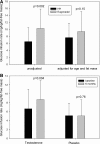Hypogonadotropic Hypogonadism in Men With Diabesity
- PMID: 29934480
- PMCID: PMC6014549
- DOI: 10.2337/dc17-2510
Hypogonadotropic Hypogonadism in Men With Diabesity
Abstract
One-third of men with obesity or type 2 diabetes have subnormal free testosterone concentrations. The lower free testosterone concentrations are observed in obese men at all ages, including adolescents at completion of puberty. The gonadotropin concentrations in these males are inappropriately normal; thus, these patients have hypogonadotropic hypogonadism (HH). The causative mechanism of diabesity-induced HH is yet to be defined but is likely multifactorial. Decreased insulin and leptin signaling in the central nervous system are probably significant contributors. Contrary to popular belief, estrogen concentrations are lower in men with HH. Men with diabesity and HH have more fat mass and are more insulin resistant than eugonadal men. In addition, they have a high prevalence of anemia and higher mortality rates than eugonadal men. Testosterone replacement therapy results in a loss of fat mass, gain in lean mass, and increase in insulin sensitivity in men with diabesity and HH. This is accompanied by an increase in insulin-signaling genes in adipose tissue and a reduction in inflammatory mediators that interfere with insulin signaling. There is also an improvement in sexual symptoms, anemia, LDL cholesterol, and lipoprotein (a). However, testosterone therapy does not consistently affect HbA1c in men with diabetes. The effect of testosterone replacement on cardiovascular events or mortality in men with diabesity is not known and remains to be studied in prospective trials.
© 2018 by the American Diabetes Association.
Figures




Similar articles
-
Insulin Resistance and Inflammation in Hypogonadotropic Hypogonadism and Their Reduction After Testosterone Replacement in Men With Type 2 Diabetes.Diabetes Care. 2016 Jan;39(1):82-91. doi: 10.2337/dc15-1518. Epub 2015 Nov 29. Diabetes Care. 2016. PMID: 26622051 Free PMC article. Clinical Trial.
-
Hypogonadotrophic hypogonadism in type 2 diabetes, obesity and the metabolic syndrome.Curr Mol Med. 2008 Dec;8(8):816-28. doi: 10.2174/156652408786733658. Curr Mol Med. 2008. PMID: 19075678 Review.
-
Prevalence of subnormal testosterone concentrations in men with type 2 diabetes and chronic kidney disease.Eur J Endocrinol. 2015 Sep;173(3):359-66. doi: 10.1530/EJE-15-0359. Epub 2015 Jun 22. Eur J Endocrinol. 2015. PMID: 26101371
-
Hypogonadotropic hypogonadism in men with type 2 diabetes.Postgrad Med. 2009 May;121(3):45-51. doi: 10.3810/pgm.2009.05.2001. Postgrad Med. 2009. PMID: 19491539 Review.
-
Late-onset hypogonadism: metabolic impact.Andrology. 2020 Nov;8(6):1519-1529. doi: 10.1111/andr.12705. Epub 2019 Sep 25. Andrology. 2020. PMID: 31502758 Review.
Cited by
-
Male Obesity-related Secondary Hypogonadism - Pathophysiology, Clinical Implications and Management.Eur Endocrinol. 2019 Aug;15(2):83-90. doi: 10.17925/EE.2019.15.2.83. Epub 2019 Aug 16. Eur Endocrinol. 2019. PMID: 31616498 Free PMC article. Review.
-
Rapid Changes in Serum Testosterone in Men With Newly Diagnosed Type 2 Diabetes With Intensive Insulin and Metformin.Diabetes Care. 2021 Apr;44(4):1059-1061. doi: 10.2337/dc20-1558. Epub 2021 Feb 3. Diabetes Care. 2021. PMID: 33536253 Free PMC article.
-
Beyond the Metabolic Syndrome: Non-Obvious Complications of Obesity in Children.Children (Basel). 2023 Dec 9;10(12):1905. doi: 10.3390/children10121905. Children (Basel). 2023. PMID: 38136107 Free PMC article. Review.
-
Remission of type 2 diabetes following long-term treatment with injectable testosterone undecanoate in patients with hypogonadism and type 2 diabetes: 11-year data from a real-world registry study.Diabetes Obes Metab. 2020 Nov;22(11):2055-2068. doi: 10.1111/dom.14122. Epub 2020 Jul 15. Diabetes Obes Metab. 2020. PMID: 32558149 Free PMC article.
-
Recent Update on the Molecular Mechanisms of Gonadal Steroids Action in Adipose Tissue.Int J Mol Sci. 2021 May 14;22(10):5226. doi: 10.3390/ijms22105226. Int J Mol Sci. 2021. PMID: 34069293 Free PMC article. Review.
References
-
- Dhindsa S, Prabhakar S, Sethi M, Bandyopadhyay A, Chaudhuri A, Dandona P. Frequent occurrence of hypogonadotropic hypogonadism in type 2 diabetes. J Clin Endocrinol Metab 2004;89:5462–5468 - PubMed
-
- Bhasin S, Brito JP, Cunningham GR, et al. . Testosterone therapy in men with hypogonadism: an Endocrine Society clinical practice guideline. J Clin Endocrinol Metab 2018;103:1715–1744 - PubMed
Publication types
MeSH terms
Substances
Grants and funding
LinkOut - more resources
Full Text Sources
Other Literature Sources
Medical
Miscellaneous

